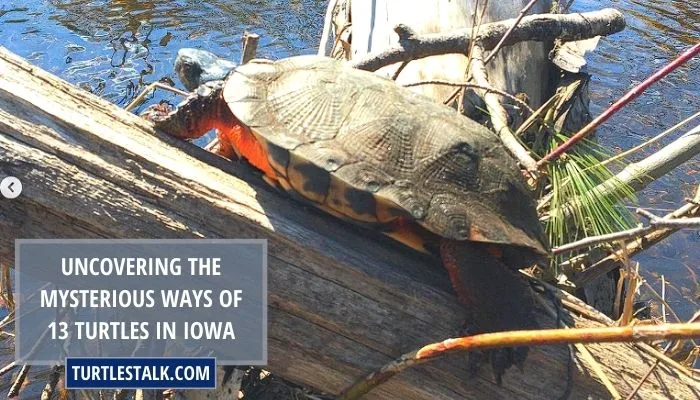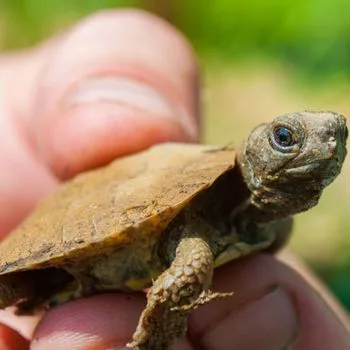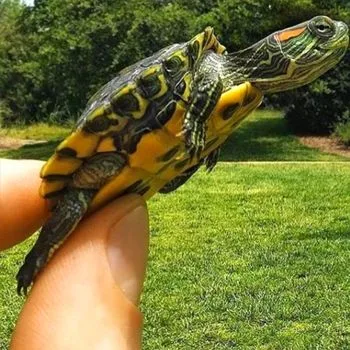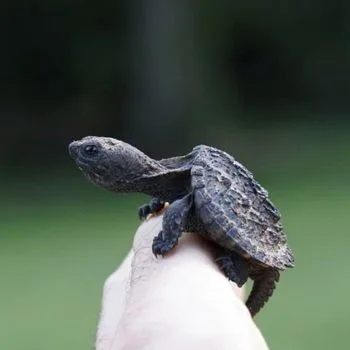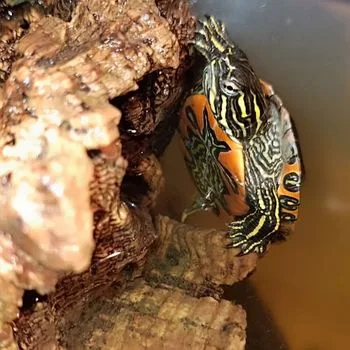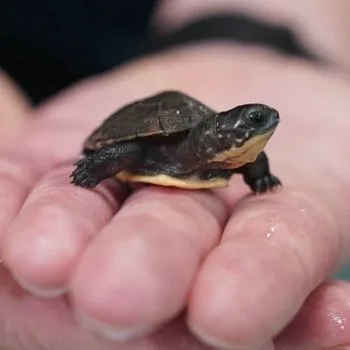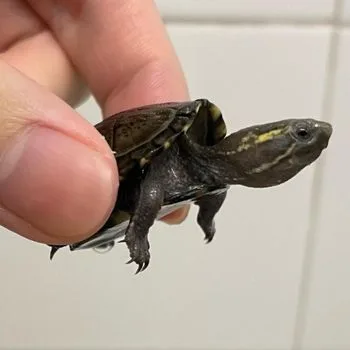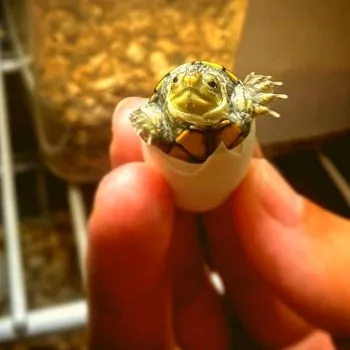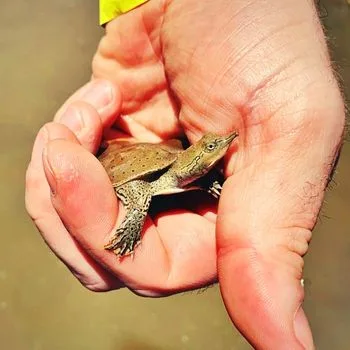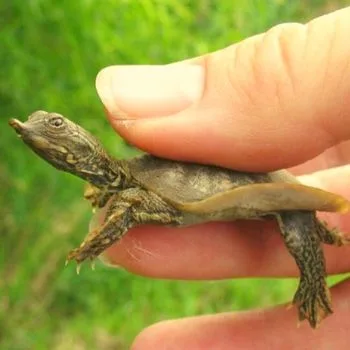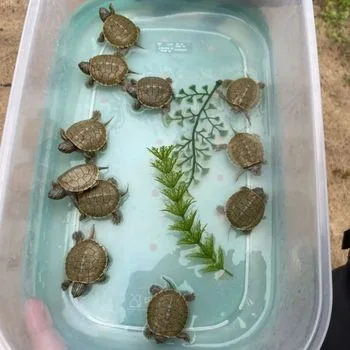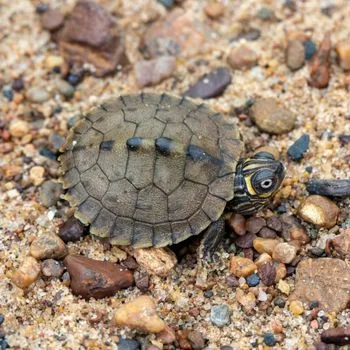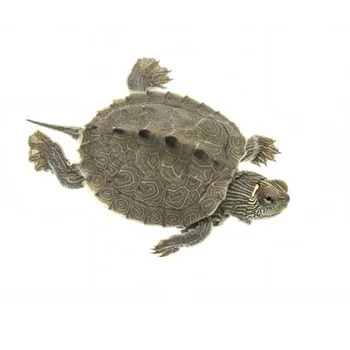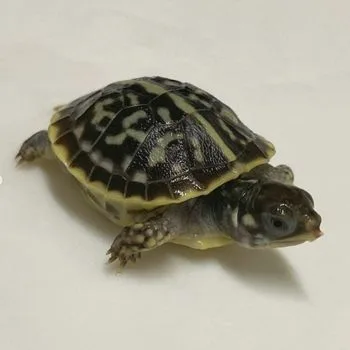Uncovering the Mysterious Ways of 13 Turtles in Iowa
Iowa is a state that is home to 13 different species of turtles! From mud turtles and map turtles to musk turtles, softshells, snappers, pond sliders and even wood turtles – you can find them all here.
Iowa may not be the most obvious place for turtle spotting but this diverse range of species makes it a great destination for wildlife enthusiasts looking to observe these amazing creatures in their natural habitat.
In addition, there are also plenty of conservation efforts underway aimed at preserving and protecting these unique animals from threats such as poaching and climate change. So come explore Iowa’s fascinating turtle population today!
| # | Name | Details | Image |
| 1 | Wood Turtle (Glyptemys Insculpta) |
| 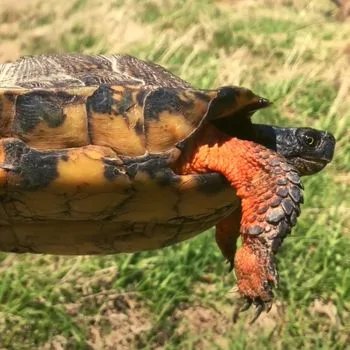 |
| 2 | Red Eared Slider (Trachemys Scripta Elegans) |
| 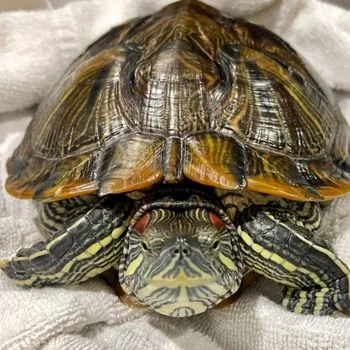 |
| 3 | Common Snapping Turtle (Chelydra serpentina) |
| 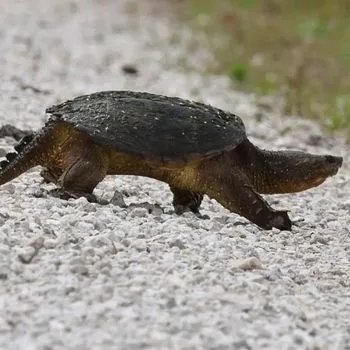 |
| 4 | Painted Turtle (Chrysemys picta) |
| 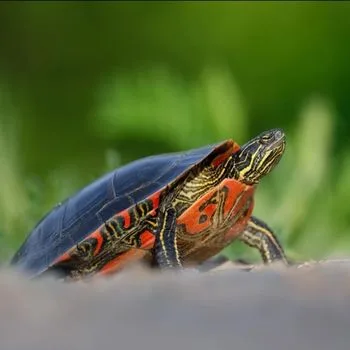 |
| 5 | Blanding Turtle (Emydoidea Blandingii) |
| 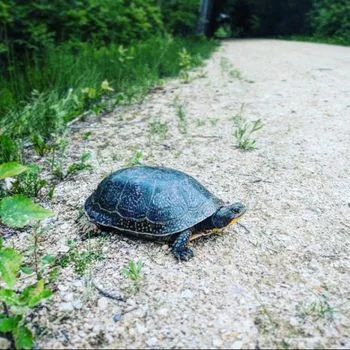 |
| 6 | Common Musk Turtle (Sternotherus Odoratus) |
| 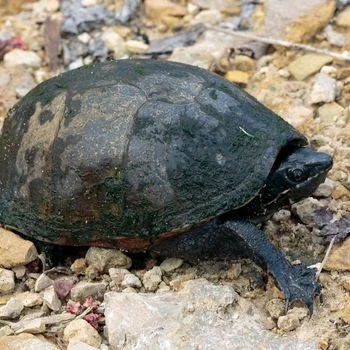 |
| 7 | Yellow Mud Turtle (Kinosternon Flavescens) |
| 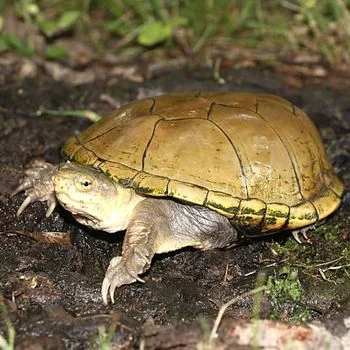 |
| 8 | Smooth Softshell Turtle (Apalone Mutica) |
| 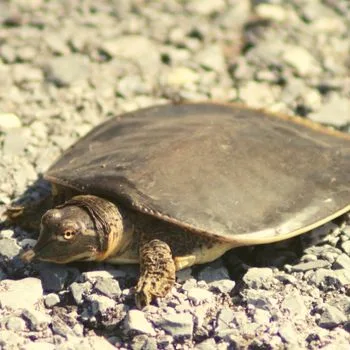 |
| 9 | Spiny Softshell Turtle (Apalone Spinifera) |
| 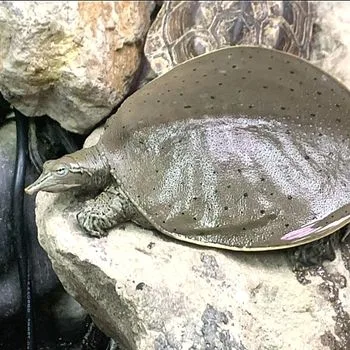 |
| 10 | Northern Map Turtle (Graptemys Geographica) |
| 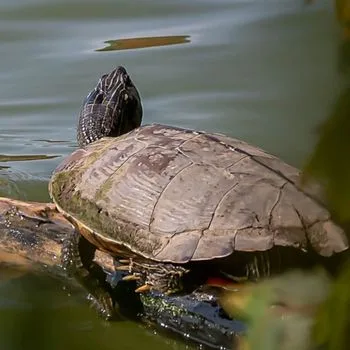 |
| 11 | Ouachita Map Turtle (Graptemys Ouachitensis) |
| 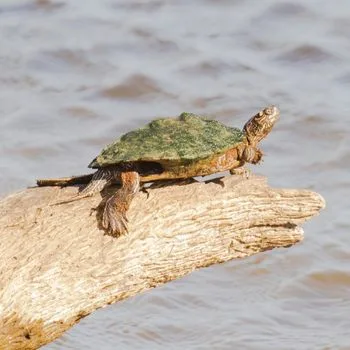 |
| 12 | False Map Turtle (Graptemys Pseudogeographica) |
| 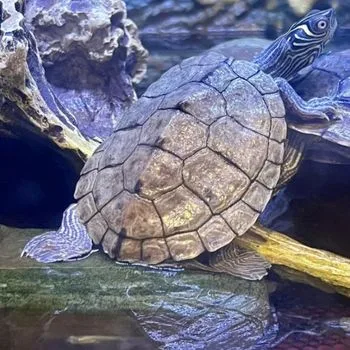 |
| 13 | Ornate Box Turtle (Terrapene Ornata Ornata) |
| 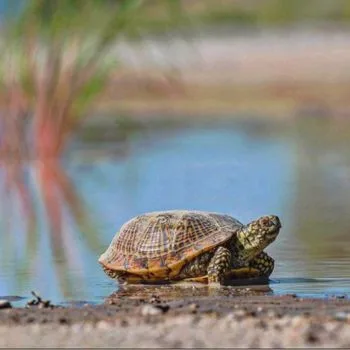 |
13 Turtles You Can Find in Iowa
In total, there are 13 species of turtles in the state of Iowa. This guide will take you on an exploration through each turtle type and provide tips for providing them with proper care. So, let’s get started on our journey into discovering all the wonders that these reptiles have to offer!
1. Wood Turtle (Glyptemys Insculpta)
- Family: Emydidae
- Genus: Glyptemys
- Type: Semi-aquatic turtle
- Natural Habitat: They prefer to sleep in streams surrounded by forests during the winter but venture out to grasslands, barren areas, and sandy shores for food and nesting during the spring.
- Lifespan: 12+ years
- Maximum Size: 6 to 10 inches
- Maximum Weight: 0.5 – 2 pounds
- Prone to Diseases: Selenosis, metabolic disease
- Disease Carrier: Salmonella
- Aggression Level: Not aggressive
- Predators: Raccoons, coyotes, and foxes, arious mammals, fishes, and birds prey
- Domestication: Can be kept as pet if collected from a collector
The wood turtle (Glyptemys insculpta) is a semi-aquatic species of reptile native to Eastern North America, ranging from Nova Scotia to West Virginia. It is distinguishable by its dark coloring, with yellowish and orange markings across the shell that can even become brighter in the sun.
Typically measuring between 6 – 10 inches and weighing half a pound up to two pounds, the wood turtle that inhabits Iowa is both an impressive sight and hardy survivor.
Found mainly near forests where it spends winters asleep in streams, these turtles often venture into grasslands or sandy shores for food during the spring months. Wood turtles aren’t typically aggressive but must still beware as raccoons, coyotes and foxes are among their predators. They even possess a powerful bite force that allows them to break through shells!
2. Red Eared Slider (Trachemys Scripta Elegans)
- Family: Emydidae
- Genus: Trachemys
- Type: Aquatic turtle
- Natural Habitat: Streams, rivers, ponds, lakes, swamps, and marshes
- Lifespan: 20 – 30 years
- Also Known As: Red-eared terrapin
- Maximum Size: 7 – 12 inches, females get larger than 12 inches
- Maximum Weight: 3 – 6 pounds
- Prone to Diseases: Respiratory infections, shell rot, and other diseases if kept in unsanitary conditions.
- Disease Carrier: Salmonella
- Aggression Level: Not aggressive
- Predators: Raccoons, otters, fish, frogs, snakes, skunks and birds
- Domestication: Can be kept as pets
The Red Eared Slider (Trachemys scripta elegans) is a freshwater reptile with a striking appearance. Found in Iowa’s waterways, these turtles can reach up to 10-12 inches long as adults and can live for an impressive 30 years. They have webbed feet that are adapted for swimming, making them incredibly agile aquatic creatures.
Males and females exhibit different size ranges, with males being more diminutive compared to the females and juveniles measuring only 2-3 inches when fully grown. Although they may take on aggressive postures if threatened, their bite force is not enough to cause any damage to humans or other larger animals.
It’s important that we respect the habitats of these amazing reptiles so that future generations will be able to enjoy them too – keep their environments clean by disposing of garbage properly and avoid disturbing the fragile ecosystems where they make their homes!
3. Common Snapping Turtle (Chelydra serpentina)
- Family: Chelydridae
- Genus: Chelydra
- Type: Freshwater turtle
- Natural Habitat: Freshwater habitats such as lakes, rivers, and swamps
- Lifespan: 50 years
- Maximum Size: 19 inches
- Maximum Weight: 40 pounds
- Prone to Diseases: Fungal infections and shell rot
- Aggression Level: Not aggressive until provoked
- Predators: River otters, bears and coyotes
- Domestication: Not recommended as pets
The Common Snapping Turtle, scientifically known as Chelydra serpentina, is an aquatic species native to freshwater habitats such as lakes, rivers and swamps. These turtles are highly adaptable and can live up to 50 years in the wild.
Adult Common Snapping Turtles typically measure 10-16 inches in shell length but can grow up to 19 inches and weigh around 40 pounds. They have a powerful bite with an estimated pressure of over 600 psi, making them one of the strongest biters among reptiles. Despite their strength they are generally not aggressive animals, though it is best to not provoke them and take caution around them.
Common Snapping Turtles often face threats from predators such as river otters, bears and coyotes when living out in the wild.
Unfortunately, their habitat is also threatened by human activities such as development and pollution which can lead to a decrease in population numbers if conservation efforts are not taken soon here in Iowa.
Although they make fascinating pets due to their long lifespan of up to 50 years when cared for properly, some states have regulations or restrictions on owning them so check with local authorities before acquiring this species as a pet.
These turtles have webbed feet for swimming and a long tail for propulsion allowing them to move quickly through water which also makes them difficult prey for predators.
Furthermore, although they occupy multiple states across North America from Alabama to Wyoming there is no other name than the Common Snapping Turtle so it’s easy to identify.
It should be noted that this species does not carry any significant disease that can be transmitted to humans yet they may still be prone to diseases like fungal infections or shell rot when kept in unsanitary conditions so proper care must be taken here in Iowa when considering owning one of these remarkable creatures as a pet.
4. Painted Turtle (Chrysemys picta)
- Family: Emydidae
- Genus: Chrysemys
- Type: Aquatic turtle
- Natural Habitat: Rivers, streams, and large ponds in the northern united states
- Lifespan: 20 – 30 years
- Maximum Size: Males: can reach up to 5.5 – 6 inches, females: 5 – 10 inches
- Maximum Weight: Males: roughly 300 gm, females: on avg 500 gm
- Prone to Diseases: Shell infections
- Disease Carrier: Salmonella
- Aggression Level: Not aggressive
- Predators: Raccoons, skunks, foxes, herons, other birds, snakes, and large predaceous fish
Have you ever wanted to own a beautiful and unique pet? The Painted Turtle (Chrysemys picta) may just be the perfect fit for you!
Native to North America, this semi-aquatic reptile lives in Iowa’s rivers, lakes, marshes and ponds. The carapace length of these turtles ranges from 4-10 inches long with females being larger than males.
With proper care and clean living conditions, they have an average lifespan of 20-30 years – making them great companion animals for your family or even as solo pets. Just make sure to check what regulations there are in Iowa so that you can give your pet painted turtle the best life possible!
5. Blanding Turtle (Emydoidea Blandingii)
- Family: Emydidae
- Genus: Emydoidea
- Type: Freshwater turtle
- Natural Habitat: Marshes, swamps, ponds, and slow-moving streams in eastern north america
- Lifespan: 20-30 years
- Maximum Size: 8-10 inches in carapace length
- Maximum Weight: 1-2 pounds
- Prone to Diseases: Shell rot, respiratory infections, and skin infections
- Aggression Level: Mild
- Predators: Juveniles and eggs – raccoons, skunks, and birds; adults – large fish and otters
- Domestication: Not suitable as pets
Native to the marshes, swamps, ponds, and slow-moving streams of Eastern North America, the Blanding Turtle (Emydoidea Blandingii) is a freshwater turtle. Adults measure 8-10 inches in carapace length, and weigh around 1-2 pounds, with little variation between male and female sizes.
These turtles are mild and usually not aggressive, though juveniles and eggs can be preyed on by raccoons, skunks, and birds. Adult Blanding Turtles in Iowa can be preyed on by large fish, otters, and humans.
Due to habitat loss and exploitation for the pet trade, these turtles are listed as a Species of Special Concern in some states including Maine, New York, Ohio, and Indiana. However, they are not suitable as pets as they require specialized habitats to thrive. Furthermore, if kept captive they can suffer from illnesses like shell rot or respiratory infections if not maintained properly.
Blanding Turtles are strong swimmers well adapted to life in the water. Conservation efforts should continue in the state of Iowa in order to protect this species which plays an important role in maintaining healthy ecosystems within its range from Eastern North America.
Moreover, educational initiatives should be established to educate people about the significance of protecting these turtles before their population further declines.
6. Common Musk Turtle (Sternotherus Odoratus)
- Family: Kinosternidae
- Genus: Sternotherus
- Type: Terrestrial and aquatic turtle
- Natural Habitat: Streams, rivers, ponds, and swamps in eastern north america
- Lifespan: 10-20 years
- Also Known As: Stinkpot
- Maximum Size: 4-8 inches
- Maximum Weight: 0.7 pounds
- Prone to Diseases: Respiratory infections and shell rot
- Aggression Level: Agressive but not known to bite humans
- Predators: Raccoons, mink, birds of prey, and large fish
- Domestication: Can be kept as pets
The Common Musk Turtle (Sternotherus Odoratus) is a terrestrial and aquatic turtle found in streams, rivers, ponds, and swamps throughout the eastern United States. This species can reach an impressive length of 4-8 inches when fully grown, with an average weight of 0.7 pounds. Interestingly, these turtles are also known as ‘Stinkpots’ due to their ability to secrete a musky odour when alarmed or threatened.
Their flat carapace makes them well adapted for life in the water, with strong webbed feet and sharp claws helping them cling onto rocks or vegetation while searching for food. As omnivores they feed on snails, clams and other insects as well as plant matter such as algae and leaves – making them a vital part of the local ecosystem here in Iowa. They are generally non-aggressive but may bite if disturbed or threatened by predators such as river otters, raccoons, mink and birds of prey.
The Common Musk Turtle is not currently listed as an endangered species but habitat loss due to human activities such as development and pollution can lead to a decrease in population numbers – especially without proper conservation efforts. Additionally, illegal pet trade can be an issue that affects their vulnerability so it’s important to check local regulations before acquiring this species as a pet.
Despite all this however, with proper care these turtles have been known to live up to 20 years making them great companions for experienced keepers who are willing to put in the effort necessary for their special care needs here in Iowa.
7. Yellow Mud Turtle (Kinosternon Flavescens)
- Family: Kinosternidae
- Genus: Kinosternon
- Type: Freshwater turtle
- Natural Habitat: Found in habitats ranging from slow-moving rivers to permanent ponds, including floodplain swamps and seasonal wetlands.
- Lifespan: 20 – 30+ years
- Maximum Size: 5 – 12 inches
- Maximum Weight: 10 – 35 pounds
- Prone to Diseases: Shell disease
- Disease Carrier: Salmonella
- Aggression Level: Not aggressive
- Predators: Raccoons, alligators
- Domestication: Can be kept as pets
The Yellow Mud Turtle (Kinosternon flavescens) is a remarkable creature, found in habitats ranging from slow-moving rivers to permanent ponds. This freshwater turtle is typically 5 to 12 inches long and can live up to 30 plus years! It has an interesting yellowish shell with black markings on its upper carapace that sometimes feature red or orange hues along the edges; making it stand out among other species of turtles.
Yellow mud turtles are not aggressive creatures, preferring solitude apart from mating season when we often find several males competing for the same female. These reptiles have many predators such as raccoons and alligators who prey on them easily due to their small size and lack of protection against enemies.
Sadly, this species faces endangerment in Iowa due largely to destruction of its habitats which require conservation efforts if we wish future generations will enjoy seeing Yellow Mud Turtles back thriving in nature just like today!
8. Smooth Softshell Turtle (Apalone Mutica)
- Family: Trionychidae
- Genus: Apalone
- Type: Mud turtle
- Natural Habitat: Marshes, streams, drainage ditches, and occasionally ponds.
- Lifespan: 10 to 20 years
- Also Known As: American softshell turtles
- Maximum Size: Males: 4 – 7 inches, females: 7 – 12+ inches
- Maximum Weight: 40+ pounds
- Prone to Diseases: Metabolic bone disease
- Disease Carrier: Foodborne infections, vibrio cholerae
- Aggression Level: Aggressive
- Predators: Turtle eggs are a food source for birds such as racoons and red foxes, as well as bears. younger turtles are prey for large fish and other turtles, as well as mammals like the skunk and armadillo. alligators are the main danger to adult turtles.
- Domestication: Can be kept as pets
The Smooth Softshell Turtle (Apalone mutica), is an aquatic species of turtle found across parts of the United States, including Iowa, Mississippi River valley, Great Lakes region and mid-Atlantic states. With a carapace length making them among the largest freshwater turtles in North America – they range from 4 to 8 inches in size when young but can grow up to 28 inches long and weigh up to 20 pounds as adults.
This unique species has evolved many features that make them ideal for life underwater; possessed with powerful webbed feet for swimming, sharp claws for clinging onto submerged rocks and a flat shell which helps reduce drag – allowing them to move quickly and efficiently through their surroundings.
Unfortunately however, due to loss of habitat, hunting and other factors some populations are now threatened or endangered. Despite this somber message though; I am encouraged that these creatures remain safe from commercial exploitation elsewhere meaning there is still hope yet for this remarkable species!
9. Spiny Softshell Turtle (Apalone Spinifera)
- Family: Trionychidae
- Genus: Apalone
- Type: Freshwater turtle
- Natural Habitat: Predominantly discovered in rivers and lakes, can also be found in nearby creek beds and smaller water bodies such as ditches and ponds.
- Lifespan: 40+ years
- Also Known As: Spinifera (spine-bearing), spiny
- Maximum Size: 8 – 20+ inches
- Maximum Weight: 25 pounds
- Prone to Diseases: Vitamin deficiencies, metabolic bone disease, and intestinal parasites
- Disease Carrier: Foodborne infections, vibrio cholerae
- Aggression Level: Aggressive when threatened
- Predators: Raccoons, skunks, and foxes frequently disrupt the nesting sites of spiny softshell turtles. while young softshell turtles face predation from raccoons, herons, and big fish, adult turtles mainly fall victim to human hunting and lack significant natural predators.
- Domestication: Cane be kept as pets
The Spiny Softshell Turtle (Apalone Spinifera) is a species of freshwater turtle found in the rivers, streams and lakes across Iowa. They are an impressive creature with adults reaching 8-14 inches in length and males weighing up to 3 pounds while females can reach up to 8 pounds. These turtles have remarkable adaptations such as webbed feet, streamline shells and long snorkel like nasal tubes for breathing underwater.
Unfortunately, some populations of these beautiful creatures may be declining due to rapid habitat loss or exploitation but luckily they are not currently listed as endangered species – yet.
When given proper care, maintenance and facilities these turtles can make great pets; however it’s best practice to always check with local authorities first because it might be illegal from state to state. They are usually quite gentle but can become aggressive when feeling threatened or cornered so it’s crucial for their owners to educate themselves about how best handle them correctly.
By taking the necessary steps we can ensure that this amazing species will continue to thrive!
10. Northern Map Turtle (Graptemys Geographica)
- Family: Emydidae
- Genus: Graptemys
- Type: Aquatic turtle
- Natural Habitat: Rivers, streams, and large ponds in the northern united states
- Lifespan: 20+ years
- Also Known As: Common map turtle
- Maximum Size: Males: can reach up to 6 inches, females: can reach up to 10 inches
- Maximum Weight: Males: 150-400 gm, females: 1.5-5.5 pounds
- Prone to Diseases: Contaminants due to the diet habit
- Aggression Level: Not aggressive
- Predators: Racoons, coyotes and skunks
- Domestication: Can be kept as pet
The Northern Map Turtle (Graptemys geographica) is a species of aquatic turtle native to the rivers, streams and large ponds in the northern United States. They can reach up to 10 inches in carapace length with male size being smaller than female. Adults don’t have many natural predators but juveniles are preyed upon by birds, mammals and larger fish.
These strong swimmers have an excellent carapace for protection from danger and they can live up to 20-25 years if properly cared for! Given their beautiful markings, it’s no surprise that these turtles are becoming increasingly popular as pets – just remember they must be treated with care and may require permits depending on the state, including Iowa. They’re also prone to respiratory infections when kept in captivity so it’s important to monitor them closely.
Luckily, this majestic species isn’t endangered yet – though population numbers may be decreasing rapidly in certain areas. The Northern Map Turtles can are easily found living around Illinois, Indiana, Iowa, Michigan, Minnesota, Missouri, Ohio, and Wisconsin among other US states!
11. Ouachita Map Turtle (Graptemys Ouachitensis)
- Family: Emydidae
- Genus: Graptemys
- Type: Aquatic turtle
- Natural Habitat: Slow-moving freshwater rivers, streams, and lakes
- Lifespan: 30 – 50 years
- Also Known As: Sawback
- Maximum Size: Males: 3 to 6.5 inches, females: 4.0 to roughly 11 inches
- Maximum Weight: 1.5 – 4.5 pounds
- Prone to Diseases: Shell rot, respiratory infections
- Disease Carrier: Salmonella
- Aggression Level: Not aggressive
- Predators: Raccoons, skunks, and foxes
- Domestication: Can be kept as pet
Have you ever seen the magnificent Ouachita Map Turtle (Graptemys ouachitensis)? This freshwater turtle is found in slow-moving rivers, streams, and oxbow lakes in Arkansas and Oklahoma.
With adult sizes measuring 8-11 inches in length, these turtles make for a great pet – though it’s important to check local regulations as Iowa may have different restrictions when it comes to owning a turtle.
They are not aggressive by nature but can fall prey to predators like raccoons and otters or even large fish or birds of prey on occasion. When cared for properly, these turtles can live up to 20-30 years!
12. False Map Turtle (Graptemys Pseudogeographica)
- Family: Emydidae
- Genus: Graptemys
- Type: Freshwater turtle
- Natural Habitat: Large rivers, lakes and backwaters of the mississippi river system
- Lifespan: 10 to 20 years
- Maximum Size: Females 8-10 inches; males reach 4-6 inches
- Maximum Weight: Females 4 lbs; males 0.8 lbs
- Prone to Diseases: Respiratory infections, shell rot, and other health issues
- Aggression Level: Low
- Predators: Birds of prey, raccoons, and other large mammals
- Domestication: Can be kept as pets
False Map Turtles are freshwater turtles native to the large rivers, lakes and backwaters of the Mississippi River system. Males grow up to 6 inches in length and can weigh up to 0.8lbs, while females typically reach 8-10 inches in size and weigh 4 lbs.
This species is well adapted for aquatic life – with a streamlined shell and strong legs for swimming, they are graceful swimmers. Best known for their intricate map-like shell patterning, these turtles have relatively low levels of aggression so can be kept as pets under supervision with proper care and nutrition.
Despite not being considered endangered yet, we must protect False Map Turtle habitats throughout Iowa before populations decline further due to habitat loss or collection for the pet trade!
13. Ornate Box Turtle (Terrapene Ornata Ornata)
- Family: Emydidae
- Genus: Terrapene
- Type: Terrestrial turtle
- Natural Habitat: Open landscapes such as pastures, prairies, and lightly forested areas
- Lifespan: 30 – 40 years
- Also Known As: Western box turtle
- Maximum Size: 4-5 inches
- Maximum Weight: 1-1.5 pounds
- Prone to Diseases: Vitamin deficiency, respiratory diseases
- Disease Carrier: Salmonella
- Aggression Level: Males display a tendency towards aggressive behavior, including biting and clashing their shells against each other
- Predators: Birds, such as crows, raptors, and ravens; domestic cats and dogs; opossums; raccoons; skunks; snakes; and even adult box turtles
- Domestication: Can be kept as pet
Have you ever wondered what kind of magical creature might be lurking in the forests and wetlands of Iowa? Well, say hello to the Ornate Box Turtle! This amazing animal is closely related to its box turtle cousins, but it can also be identified by its intricate patterned shell – hence its name.
With a small head and body covered in an ornately patterned carapace or upper shell that’s usually brown with yellowish-orange markings, these turtles stand out from the crowd.
It spends most of its time hiding under cover while searching for food such as snails and insects, often seen out on warm summer days. So next time you take a walk through Iowa, keep your eyes open for the Ornate Box Turtle – after all, who knows what else might be living there!
Final Words
In the state of Iowa—a place rich in biodiversity—turtles play a significant role; with a variety of species dwelling in its forests, beaches, and rivers.
In this article, we took a closer look at these fascinating creatures (including their natural habitats, lifespan, size and weight, predators, and domesticability). It’s worth noting that, while keeping these turtles as pets is legal; their populations in Iowa may be declining due to habitat loss and collection for the pet trade.
It is our responsibility to ensure that these turtles remain protected and preserved for future generations to enjoy in the state of Iowa.
Other Nearby States:
- Turtles In Nebraska
- Turtles In South Dakota
- Turtles In Wisconsin
- Turtles In Illinois
- Turtles In Minnesota
- Turtles In Missouri

